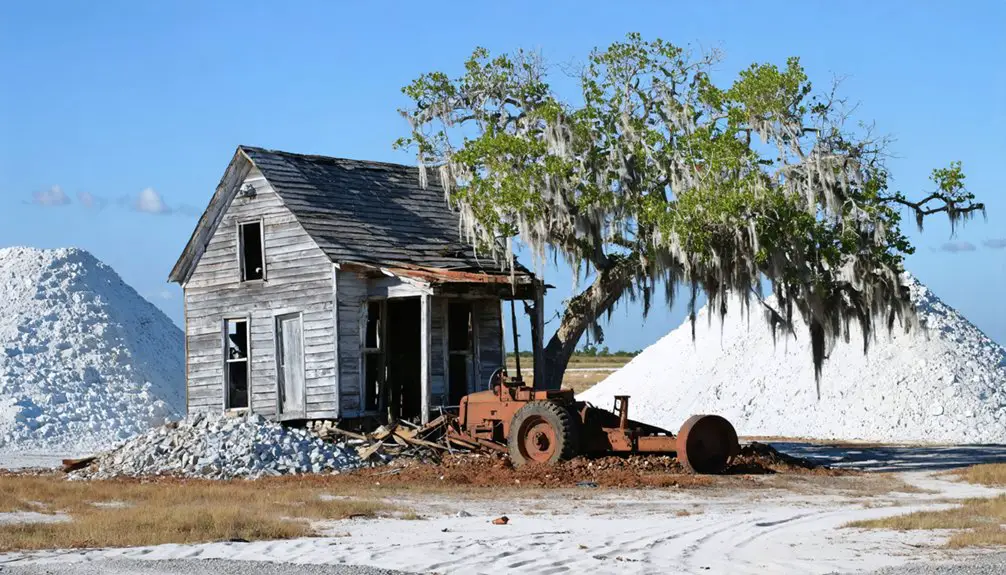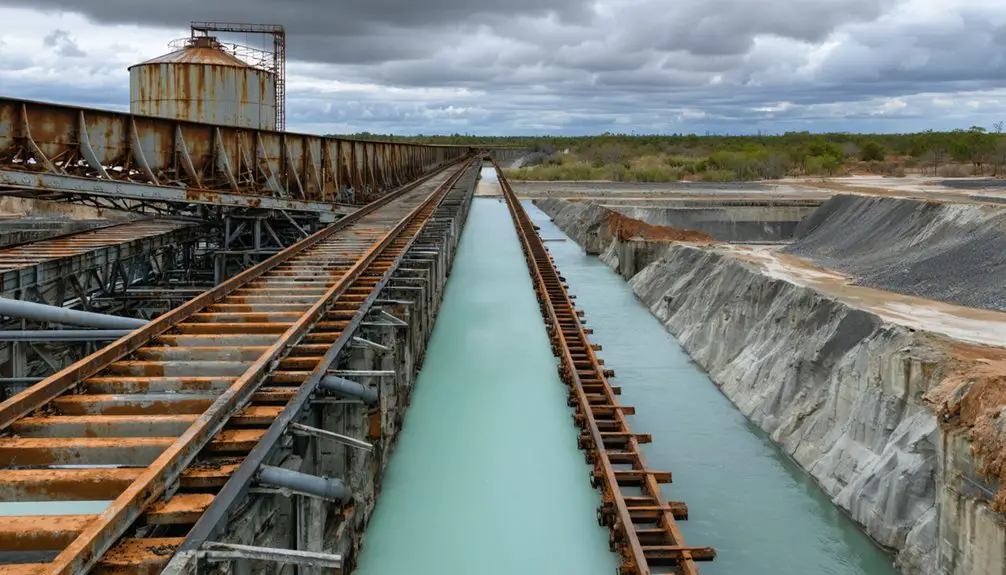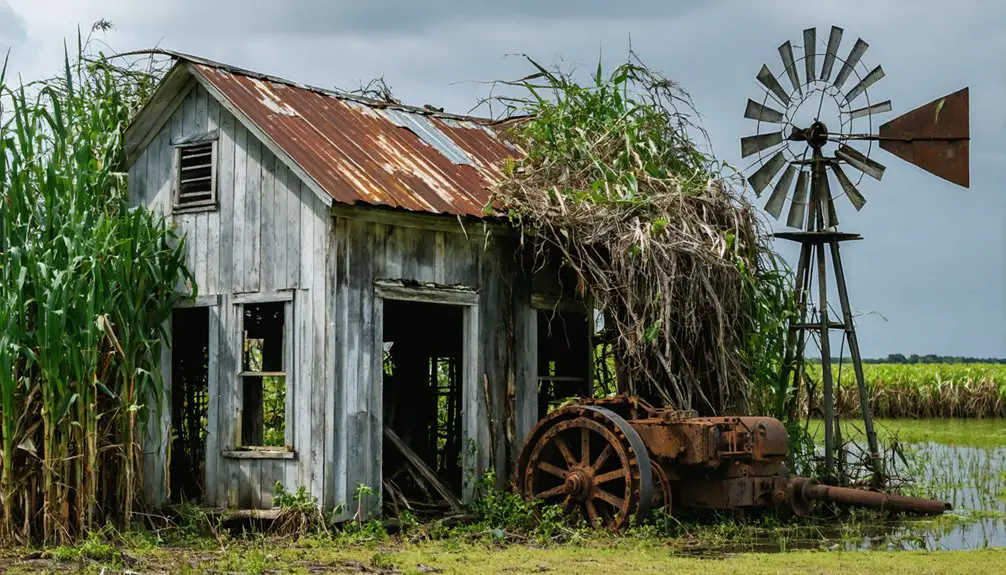You’ll find Agricola, Florida, 15 kilometers southwest of Bartow, where Swift and Company established a bustling company town in 1907. Workers lived in company-owned houses, supported by local shops, schools, and community spaces while working in food processing and phosphate mining operations. The town’s fortunes changed during the early 20th century’s Great Exodus, as residents moved north for better opportunities. Today, the transformed landscape tells a story of industrial ambition and environmental change.
Key Takeaways
- Agricola was established in 1907 by Swift and Company as a company town near Bartow, Florida, focused on food processing and phosphate mining.
- The town featured company-owned housing, shops, schools, and community facilities, all built within walking distance of industrial operations.
- Workers and families lived in standardized cottages with modern amenities, creating a close-knit community centered around factory work schedules.
- The site’s phosphate mining operations contributed to Florida becoming America’s leading phosphate producer by 1910.
- Today, Agricola exists only as a ghost town, with its land transformed by modern phosphate mining operations conducted by companies like Mosaic.
The Birth of a Company Town
When Swift and Company established Agricola in 1907, they created more than just a workplace – they built an entire community 15 kilometers southwest of Bartow, Florida.
You’ll find this fascinating example of early 20th-century company culture nestled at an elevation of 167 feet, where both food processing and phosphate mining operations shaped its industrial legacy.
The town’s strategic location near the intersection of Agricola Road and Agricola Mine Road wasn’t chosen by accident. The name itself required careful internal link navigation to distinguish it from other places sharing the Agricola designation.
Much like the land of friendly people that would become Apalachicola, this company town was designed to foster a sense of community among its residents.
Swift and Company designed their self-contained community to support a dual industrial focus, combining food processing with the booming phosphate industry of Bone Valley.
Every aspect of the town’s development reflected their vision of a controlled, efficient workplace environment where workers would live, work, and build their lives under the company’s watchful eye.
Swift and Company’s Vision
Swift and Company’s ambitious expansion into Agricola reflected their proven strategy of establishing company towns near key transportation and livestock supply routes.
You’ll find their approach mirrored successful developments in places like Fort Worth, where they’d secured government subsidies and built extensive worker housing communities. The company’s innovative use of refrigerated railway cars transformed meat distribution across America. Their vacuum-packaging techniques revolutionized meat preservation and storage capabilities across the industry.
Their vision for Agricola included not just a meatpacking facility but a complete industrial town with modern worker accommodations, following the blueprint that had helped them grow into a $200 million enterprise by 1903.
Company Town Development Strategy
During the early 1900s, Swift and Company implemented an ambitious development strategy for company towns like Agricola, focusing on creating self-contained communities that served their industrial expansion goals.
You’d find these carefully planned settlements featured company-owned housing, shops, and schools, all designed to maintain tight company control over the workforce dynamics.
Swift’s strategy went beyond just providing basic housing – they invested in extensive community infrastructure to guarantee worker loyalty and reduce turnover. Their approach was well documented in archived collections available through various historical repositories.
By tying housing to employment status, they created a system where your ability to live in the town depended directly on your job performance.
This paternalistic approach helped Swift secure a stable workforce while anticipating future industrial growth through strategic planning of residential and commercial spaces.
Early Industrial Housing Blueprint
In accordance with Progressive Era ideals, the industrial housing blueprint at Agricola reflected Swift and Company’s extensive vision for worker accommodations in the early 1900s. The housing design emphasized efficiency and worker welfare through practical layouts that you’d find essential for daily life. Modern community design principles focus on mixed-use buildings to create vibrant neighborhoods. Similar to today’s agrihood developments, these communities aimed to be self-sustaining with essential amenities.
These modest cottages featured locally sourced materials and standardized construction methods to keep costs manageable while maintaining durability.
The blueprint included:
- Front and back porches that provided you with semi-private outdoor living spaces
- Natural lighting and ventilation systems that met contemporary health standards
- Strategic placement within walking distance of industrial operations and community amenities
You’d appreciate how the orderly arrangement of homes fostered community interaction while maintaining individual space, creating a balance between work proximity and residential comfort that was revolutionary for its time.
Life in Early Agricola
If you’d worked in early Agricola, your daily life would have centered around Swift and Company’s factory schedules, with shifts dictating your family’s routines and social activities.
You’d have found all your essential needs met within the town’s boundaries through company-provided shops, schools, and community services. Similar to how early settlers established farming settlements to be self-sufficient, these company towns aimed for independence.
Your social connections would have revolved around fellow workers and their families, creating a close-knit community bound by shared employment and living spaces. Many residents traded goods with local Native American tribes to supplement their daily necessities.
Daily Factory Worker Routines
Life for Agricola’s factory workers revolved around Swift and Company’s demanding food processing and phosphate mining operations. You’d find yourself following strict factory routines that shaped every aspect of your daily existence, from dawn until dusk.
Worker schedules typically meant 10-12 hour shifts, six days a week, with your role determined by skill level. Similar to the workers at the Sturkey lumber mill, factory employees operated heavy machinery while following strict safety protocols.
Your typical day would include:
- Walking from your company-provided house to the plant, where you’d perform physically demanding tasks like meat processing or phosphate extraction.
- Following rigorous safety and hygiene protocols while operating machinery or handling products.
- Taking coordinated meal breaks in communal areas, with your entire day structured around the plant’s production needs.
The demanding nature of the work left little time for leisure, as you’d return home exhausted to prepare for another day.
Community Support and Services
While most company towns of the early 1900s offered minimal amenities, Agricola stood out as a self-contained community with vast support services. You’d find everything needed for daily life right within the town’s borders, fostering strong community cohesion among factory workers and their families.
Swift and Company’s commitment to educational initiatives meant your children could attend local schools without traveling to distant cities. You’d shop at nearby stores, eliminating dependency on Bartow, which lay 9.3 miles away.
The company’s strategic planning guaranteed you’d access to communal spaces for social gatherings and cooperative facilities that supported worker welfare. This thorough infrastructure created a self-reliant environment where multiple generations of families could thrive, connected by shared experiences and mutual support networks.
The Phosphate Mining Era
The discovery of phosphate in Florida’s Peace River Valley in 1881 by Captain J. Francis LeBaron sparked a transformative era in Agricola’s history.
Captain LeBaron’s 1881 phosphate discovery along Florida’s Peace River Valley ignited a dramatic transformation of Agricola.
As mining companies flooded the region, land values skyrocketed from $1.25 to $300 per acre, forever changing the local landscape.
The evolution of phosphate mining techniques in Agricola followed three distinct phases:
- Manual extraction using picks and shovels in shallow pits (1888)
- River pebble operations along the Peace River and its tributaries
- Large-scale strip mining with steam shovels as deeper deposits were found
You’ll find that by 1910, this boom had positioned Florida as the nation’s leading phosphate producer, supplying 79% of the country’s phosphate for fertilizer.
The Agricola Road Site near Bradley became particularly significant, yielding both valuable minerals and important paleontological discoveries.
Daily Living and Community Spirit

Established in 1907, Agricola emerged as a purpose-built company town where Swift and Company’s workers formed an intricate social fabric. You’d find your daily needs met within walking distance, from schools to shops, all designed to support the community’s self-sufficiency.
Life revolved around the food processing plant and phosphate mine shifts, with your schedule setting the rhythm for local activities. Community engagement flourished as you’d join your neighbors at school events, local gatherings, and shared spaces.
Your children would attend the same schools as their friends, creating lifelong bonds that strengthened social cohesion. Nuclear families lived side by side, sharing not just physical proximity but the common experience of working for the same employer.
This tight-knit environment persisted until the 1950s, when operations ceased and residents relocated.
The Great Exodus
Against the backdrop of Agricola’s communal stability, a massive demographic shift swept through Florida in the early 20th century. The Great Exodus saw entire Black communities relocate northward, driven by economic pressures and the pursuit of freedom.
Florida’s early 1900s witnessed a profound transformation as Black communities fled north, seeking economic opportunity and liberation from oppression.
You’d have witnessed dramatic population changes as up to 50% of Black residents departed from some towns, fundamentally altering Florida’s social fabric.
Key aspects of these Migration Patterns included:
- Northern companies actively recruited Black workers from Florida starting in 1916
- Tampa served as a major assembly point, with nearly 5,000 people departing
- Church leaders often guided entire congregations in group migrations
This exodus reflected both the courage to seek better opportunities and the deep-seated tensions within Florida’s racial and labor systems, leaving many communities permanently transformed.
From Homes to Mining Land

Once Swift and Company laid the groundwork for Agricola in 1907, this company town sprang to life as a self-contained community 15 kilometers southwest of Bartow.
The town flourished with company-maintained homes, local shops, and schools that served the food processing and phosphate mining workers.
Traces of the Past
Today, if you visit the former site of Agricola at 27°47′16″N 81°53′29″W, you’ll find minimal physical evidence of the once-thriving company town.
The phosphate mining operations that replaced the community have drastically altered the landscape, leaving behind a transformed terrain of open pits and disturbed earth.
Archaeological discoveries remain limited, but you might encounter:
- Industrial equipment remnants from former food processing and phosphate operations
- Cultural remnants like household items buried in soil deposits
- Foundation traces from original industrial structures
While most physical structures were relocated or destroyed by the 1950s, the site’s elevation of 167 feet offers a vantage point to imagine the former town’s layout.
The mining activities have erased streets and homes, leaving only scattered clues about the community that once called this land home.
Modern Mining Operations

While the historic town of Agricola has vanished, modern phosphate mining operations now dominate the landscape, with companies like Mosaic extracting minerals across thousands of acres annually.
You’ll find massive draglines scooping up to 70 tons of earth per pass, stripping away layers of sand, clay, and phosphate pebble. These materials travel through extensive pipeline networks stretching up to 20 miles for processing.
Today’s modern mining employs advanced technologies like hydro-cyclones and hydrosizers to separate phosphate from other materials.
The environmental impact is carefully managed through settling ponds that contain clay and water, while post-mining reclamation transforms old pits into wetlands, parks, and agricultural land.
This systematic approach helps maintain both operational efficiency and environmental responsibility in Florida’s phosphate industry.
Frequently Asked Questions
Did Any Major Accidents or Disasters Occur During Agricola’s Operational Years?
You won’t find records of major railroad accidents or industrial disasters during Agricola’s active period, though nearby infrastructure development later sparked numerous accidents and mysterious occurrences along I-4.
What Happened to the School Records and Other Administrative Documents?
You won’t find most administrative documents – they’re missing after Agricola’s 1950s closure. Swift and Co.’s liquidation, plus archival challenges of the era, likely led to their destruction or loss.
Were There Any Notable Crimes or Law Enforcement Challenges?
You won’t find specific crime statistics for Agricola, as documented law enforcement challenges were minimal. Like other rural ghost towns, it likely relied on county sheriffs for sparse, irregular patrols.
Did Any Famous People or Historical Figures Visit Agricola?
Like a hidden company ledger, you won’t find records of famous visitors or historical figures in Agricola’s past. No documented evidence suggests any notable personalities ever visited this industrial town.
What Recreational Activities and Sports Were Popular Among Agricola’s Residents?
You’d have found residents enjoying baseball games, community picnics, fishing tournaments, and church-sponsored dances. Walking, biking, and hunting were everyday activities, while boxing matches entertained workers on weekends.
References
- https://en.wikipedia.org/wiki/Agricola
- https://floridatrailblazer.com/category/ghost-towns/page/2/
- https://www.youtube.com/watch?v=lKufguzO19k
- https://www.tiktok.com/@socialshepherdadventures/video/7342301852702100778
- https://www.pinterest.com/pin/discover-agricola-a-forgotten-company-town–82401868176570630/
- https://www.cityofapalachicola.com/community/apalachicola-history/
- https://www.wikiwand.com/en/map/Agricola
- https://www.ghosttowns.com/states/fl/agricola.html
- https://fipr.floridapoly.edu/about-us/phosphate-primer/company-towns.php
- https://www.tshaonline.org/handbook/entries/swift-and-company



